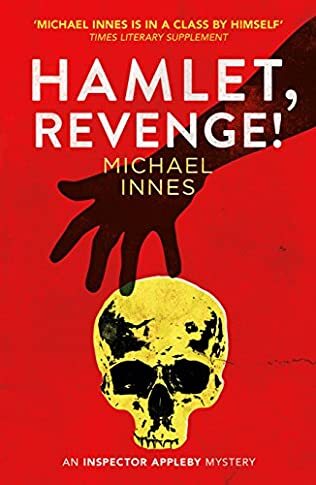Hamlet, Revenge!

A review of Hamlet, Revenge! By Michael Innes – 230326
In some senses this second outing for Michael Innes’ Scotland Yard sleuth, Inspector Appleby, is a classic country house murder mystery with a locked room element, but in reality it is as much a thriller. Originally published in 1937, I found the book difficult to get into with a first chapter containing a bewildering number of characters which, after a while, made it difficult to remember who was who as they all blurred into an amorphous mass. However, I fought off the temptation to put the book down and settle for an easier read and was rewarded with a clever, perhaps overly clever, puzzle that kept me guessing until the end.
The novel is set at Scamnum Court, seat of the Duke of Horton, where preparations are underway for a private performance of Hamlet. It is an elaborate affair, a special authentic stage is constructed, and the parts are played by some of the house party’s distinguished guests, including peers of the realm, Elizabethan scholars, doctors, a leading light of the London stage, and the Lord Chancellor, Ian Auldearn. To get us into a theatrical frame of mind, the text is laced with quotations, principally from Hamlet, and structurally the book is divided into four with a prologue, development, denouement, and epilogue.
There is an unsettling and apprehensive mood about the place, partly because of the gothic features of the building, a continuous leitmotif in the text, and partly because death threats in the form of quotations from the play have been sent to the Lord Chancellor. At a suitably dramatic moment in the play as Polonius cries out for help after being attacked, the Lord Chancellor, who is playing the part, is shot in front of the audience. It seems an incredibly rash and audacious murder and, although it was committed in front of an audience in a room where ingress and egress was prohibited, it is impossible to say whodunnit.
If the death of such a distinguished member of the government is not bad enough, the Lord Chancellor had a habit of taking state papers with him and had a particularly sensitive document, the leaking of which could destabilise international relations, on him. Were the papers safe and was the assassination the culmination of an espionage plot?
Appleby, on his way home from an evening at the ballet, arrives at his flat to find that the Prime Minister is there, and he is detailed to secure the papers and to catch whoever murdered the Lord Chancellor. On his arrival at Scamnum Court, Appleby finds an old friend, crime writer, academic and producer of the play, Giles Gott. Between the two, they set out to crack the mystery, but with up to 31 potential suspects, they have their work cut out.
What was the significance of the death threats? Were any clues to the motives and the dramatic nature of the murder contained in the plot of Hamlet? Was the murderer operating on their own or with a confederate and was the threat to the state papers a red herring or an integral part of the assassination? There is another murder, of a potential witness to the crime, and an assault on a scientist to muddle the picture further.
As befits a crime writer, Gott constructs a compelling explanation which seems to fit all the elements of the case and argues that it was the work of a solo avenger. His arguments are sufficient to convince the Chief Constable, with Appleby’s tacit consent, to make an arrest. Appleby, though, is uneasy and thanks to the sleuthing of two of the female guests, the real solution emerges, although, I have to say, it seems less convincing, especially around motivation, than Gott’s.
The book is uneven, in parts like wading through treacle, in others brisk and breezy. There are some nice touches – the gun hidden in Yorick’s skull, the black box voice analysis machine – and some humour, albeit in the form of the stereotypical Scotsman with a thick accent, the only concession to the lower orders that Innes makes and the language that describes the token non-white character, Bose, would be deemed beyond the pale these days.
If you enjoy complex puzzles that keep you guessing until the end, this is a book for you. I could take it or leave it though. On to the next.



